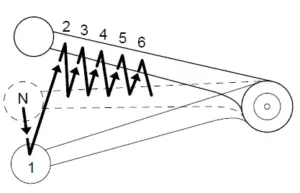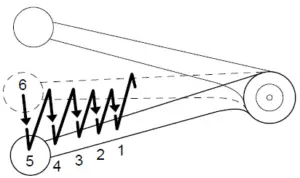2011-2023 Harley Davidson Trike Engine
Harley-Davidson has maintained its tradition of building recognizable motorcycles throughout the past ten years, and one of the company’s most notable advancements during this time has been the expansion of its Trike Engine portfolio. From 2011 until 2023, Harley-Davidson will continue to push the limits of trike motorcycle design, performance, and technology. A symbol of strength, style, and versatility on the road, the Trike Engine series during this time not only embraced the timeless essence of Harley-Davidson but also integrated contemporary engineering innovations.
All things considered, the 2011–2023 Harley-Davidson Trike Engine series is a captivating combination of history and modernity. These engines represent independence, individuality, and the enduring spirit of the open road more than just a mode of transportation. These trike engines provide an amazing riding experience that embodies the spirit of the Harley-Davidson heritage, whether you’re an experienced rider or a new member of the Harley-Davidson family.
STARTING THE ENGINE
General
Notice
The engine should be allowed to run slowly for 15-30 seconds. This will allow the engine to warm up and let oil reach all surfaces needing lubrication. Failure to comply can result in engine damage. (00563b)
Do not roll the throttle before starting. Rolling the throttle before starting the motorcycle is unnecessary.
Starting
- Turn ignition/headlamp key switch to IGNITION position. Do not roll the throttle.
Shift transmission to neutral before starting engine to prevent accidental movement, which could result in death or serious injury. (00044a) - Shift transmission to neutral.
- See Figure 38. Turn the off/run switch to RUN position.
NOTE The engine lamp will light for approximately 4 seconds and you will hear the fuel pump operating for approximately 2 seconds as it fills the fuel lines with gasoline. - Squeeze the clutch lever in against the handgrip.
NOTE To activate the starting system, the clutch interlock circuitry requires the clutch be disengaged, clutch lever pulled in against left handgrip, and/or the transmission be shifted to the neutral position (green neutral lamp - Press the starter button to start the motorcycle.
- Release the parking brake before riding the motorcycle. See CONTROLS AND INDICATORS, Reverse Operation.
NOTE If the fuel tank becomes completely dry, it may take a few seconds longer to start the motorcycle after filling the tank. It will not be necessary to take any extraordinary measures before starting the motorcycle.

- Engine off/run switch
- Engine start switch
Figure 38. Right Handlebar Controls
AUTOMATIC COMPRESSION RELEASE (ACR)
Vehicles with Twin Cam 103 and larger engines are equipped with an Automatic Compression Release (ACR). During starting, a small auxiliary valve in the cylinder head is opened automatically by the ECM. The open valve releases the air compressed in the cylinder heads and allows the starter motor to turn the high compression engine over at a faster rate to aid starting.
After starting and during normal operation, the ACR valves remain closed.
ENGINE IDLE TEMPERATURE MANAGEMENT SYSTEM
For those riders who frequently find themselves in riding con-dictions where the vehicle is subjected to prolonged idle conditions or traffic congestion, the motorcycle is equipped with an Engine Idle Temperature Management System (EITMS) to provide limited cooling of the rear cylinder.
Operation
When engine temperature reaches a pre-determined point, the EITMS will turn off the rear cylinder fuel injector. Idle speed will be maintained, however the rear cylinder will become an “air pump” which will work to cool the engine.
EITMS will activate (rear cylinder will turn off) when all of the following conditions are met.
- Engine temperature is greater than 287°F domestic (165°C international)
- Twist grip opening is at idle
- Vehicle speed under 1 mph (2 km/h)
- Engine speed under 1200 RPM EITMS will disable (rear cylinder will again fire) if any one of the following occurs:
- Engine temperature falls below 275°F domestic (135°C international)
- Twist grip opening is greater than idle
- Vehicle speed exceeds 2 mph (3 km/h)
- Engine speed exceeds 1350 RPM
- Clutch is released with vehicle in gear
When the engine is in EITMS operation, you may notice a difference in idle cadence. Additionally, there may be a unique exhaust odor. These are both considered to be normal conditions
Enabling/Disabling EITMS
Enabled: The EITMS engine cooling feature will automatically activate whenever the vehicle comes to a complete stop and is idling during elevated temperature conditions. Even with the feature enabled, it may not activate under cool riding conditions.
Disabled: The EITMS feature is not active under any conditions.
Vehicles are delivered from the factory with EITMS disabled. EITMS can be enabled or disabled by the rider by performing the following procedure.
- Turn the ignition switch to the ON position and push the engine OFF/RUN switch on the right handlebar to the RUN position (do not start the motorcycle).
- Push the throttle to roll-off position and hold.
- See Figure 7. After approximately 3 seconds, the cruise indicator lamp will either flash green (EITMS enabled) or red (EITMS disabled).
NOTE A flashing lamp indicates the EITMS setting. A solid (non-flashing) lamp indicates the cruise control setting. - Repeat the procedure as needed to enable or disable EITMS
NOTE The EITMS setting will remain in effect until it is changed by the rider or dealer. It does not have to be reconfigured at each startup.
SHIFTING GEARS Getting Started
NOTE Release parking brake before riding motorcycle. See CON-TROLS AND INDICATORS, Parking Brake.
The clutch must be fully disengaged before attempting a gear shift. Failure to fully disengage the clutch can result in equipment damage. (00182a) The shift pattern is first gear down, next five gears up.
- With motorcycle engine running and parking brake disengaged, pull the clutch hand lever in against handlebar grip to fully disengage clutch.
- Press the foot shift lever down to end of its travel and release. The transmission is now in first gear.
- To start forward motion, ease out the clutch lever slowly and at the same time, open throttle gradually.
Upshift (Acceleration)
Refer to Table 23. Engage second gear after the motorcycle has reached the appropriate shifting speed.
Table 23. Upshift (Acceleration) Gear Speeds: Six Speed
| GEAR CHANGE | mph | km/h |
| First to second | 15 | 25 |
| Second to third | 25 | 40 |
| Third to fourth | 35 | 55 |
| Fourth to fifth | 45 | 70 |
| Fifth to sixth | 55 | 85 |
- Close the throttle.
- Disengage the clutch (pull clutch lever in).
- See Figure 39. Lift the gear shift lever up to the end of its travel and release.
- Ease out the clutch lever and gradually open the throttle.
- 5. Repeat the previous steps to engage third, fourth, fifth, and sixth gears.
- NOTES
Disengage the clutch completely before each gear change. - Partially close the throttle so the engine will not drag when clutch is again engaged (clutch lever released).

Figure 39. Shifting Sequence: Upshift
Downshift (Deceleration)
Do not downshift at speeds higher than those listed. Shifting to lower gears when speed is too high can cause the rear wheel to lose traction and lead to loss of vehicle control, which could result in death or serious injury.(00045b)
Gear shift pattern is first gear down; next five gears up. Refer to Table 24 for shifting speeds.
Table 24. Downshift (Deceleration) Gear Speeds: Six Speed
| GEAR CHANGE | mph | km/h |
| Sixth to fifth | 50 | 80 |
| Fifth to fourth | 40 | 65 |
| Fourth to third | 30 | 50 |
| Third to second | 20 | 30 |
| Second to first | 10 | 15 |
NOTE
The shifting points shown in the tables are recommendations. Vehicle owners may determine that their own individual shifting patterns may differ than those stated and are additionally appropriate for individual riding styles.
See Figure 40. When engine speed decreases, as in climbing a hill or running at a reduced speed, shift to the next lower gear while partially closing the throttle so the engine accelerates as soon as the clutch lever is released.
NOTES
- Disengage the clutch completely before each gear change.
- Partially close the throttle so the engine will not drag when clutch is again engaged (clutch lever released).
Shift to neutral before stopping engine. Shifting mechanism can be damaged by shifting gears while engine is stopped. (00183a)
The gear shifter mechanism permits shifting the transmission to neutral from either first or second gear.

Figure 40. Shifting Sequence: Downshift
STOPPING THE ENGINE
- Stop the engine by turning OFF the engine stop switch on right handlebar.
- Turn OFF the ignition/headlamp key switch. If the engine should be stalled or stopped in any way, turn off the ignite tin/headlamp key switch at once to prevent battery discharge.
- Shift the transmission into gear and engage the parking brake
FAQs
Harley Davidson Trikes typically come with a range of engine options, including Milwaukee-Eight V-Twin engines with displacements between 107 and 117 cubic inches.
The Milwaukee-Eight engine’s four-valve cylinder heads provide increased power, a more refined operation, and reduced heat.
Depending on the model and engine, Harley Davidson Trikes can generate anywhere from 80 to over 120 horsepower.
It is recommended to change the oil in Harley Davidson Trike engines every 3,000 to 5,000 miles, but you should always consult your owner’s manual for the precise interval.
Harley Davidson recommends using the Harley Davidson 360 motorcycle oil, which is formulated specifically for their engines. Nevertheless, other high-quality synthetic oils that meet Harley’s requirements are also permissible.
During routine maintenance, inspect your air filter frequently and replace it if it appears soiled or obstructed. This is typically between 10,000 and 20,000 miles, but consult your owner’s manual for specifics.
Yes, there are numerous aftermarket exhaust systems available for Harley Davidson Trikes, but be sure to select one that is compatible with your specific model and engine capacity.
Yes, aftermarket components such as high-flow air filters, performance exhausts, and engine tuners can improve the performance of your Harley Davidson Trike.
Routine maintenance should be performed as specified in the owner’s manual, typically every 5,000 to 10,000 miles.
Tire pressure can vary based on model and tire type, but in general, the front tire should be between 36 and 40 psi and the rear tire should be between 40 and 44 psi.
It’s essential to consult the Harley Davidson website or contact your local dealership for information on any recalls or known issues specific to your Trike model and year.
Engine conversions are often difficult and may void your warranty. Before considering such modifications, consult a Harley-Davidson dealer or an experienced motorcycle mechanic.
Fuel efficiency varies based on engine size, riding technique, and environmental conditions, but in general, you can expect 35-45 miles per gallon (MPG).
Store your Trike in a cold, dry location, preferably with a battery tender, and adhere to the manufacturer’s winterization instructions.
Regular unleaded gasoline with an octane rating of 87 is suitable for the majority of Harley-Davidson Trikes. Unless specified in your owner’s manual, premium gasoline is typically not required.
Useful Link
View Full PDF: Harley Davidson Trike 2011-2023 User Manual | Auto User Guide
Alarm System: 2011-2023 Harley Davidson Trike Alarm System


